Electric vs Manual Standing Desks: Which One Is Right for Your Workspace?
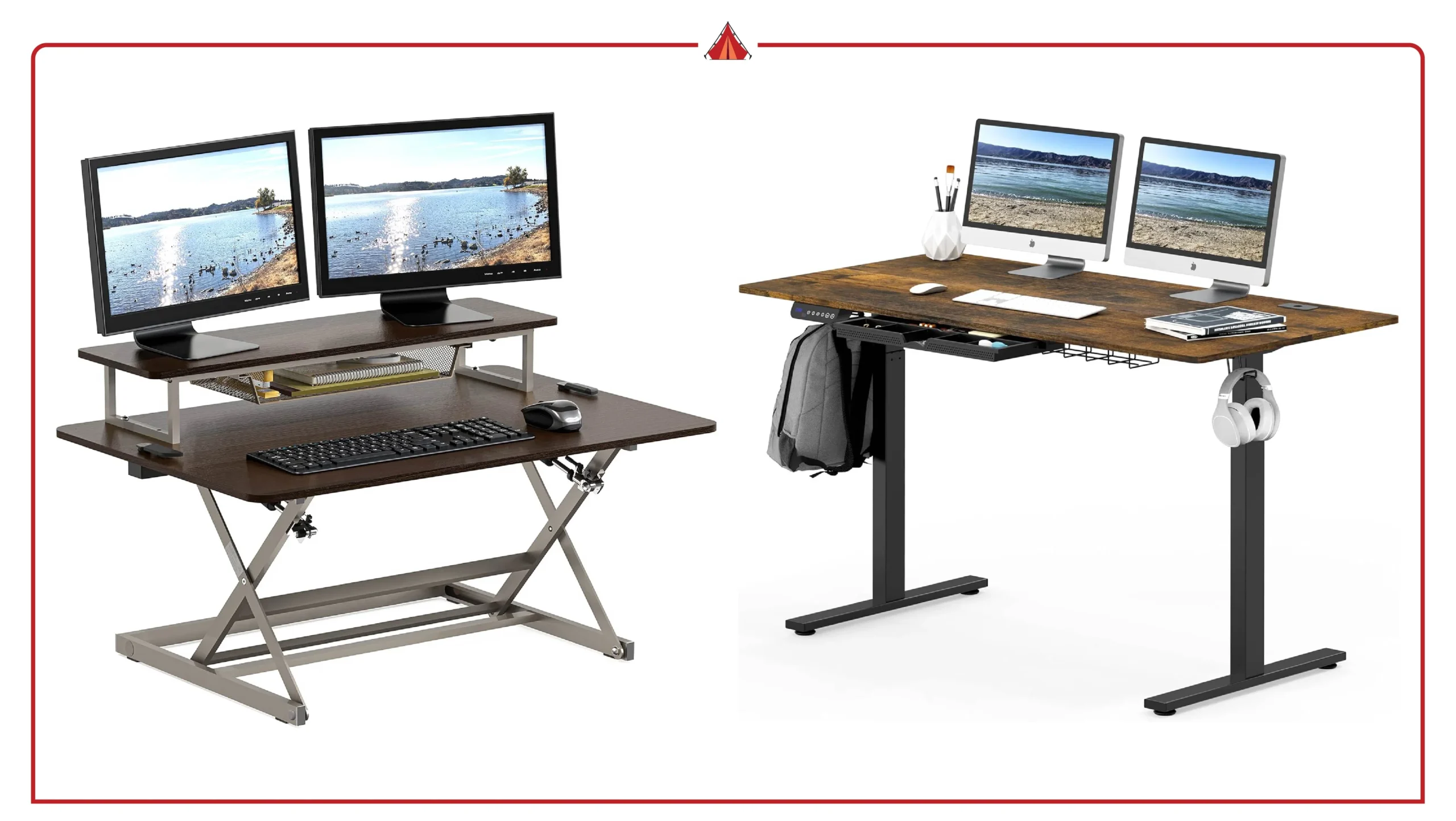
Working from home and spending long hours at a desk has made ergonomics more important than ever. Many people turn to standing desks to fight fatigue, improve posture, and create a healthier workspace. But once you decide you want a standing desk, there’s an immediate fork in the road: should you go with an electric model or a manual one?
Both options can transform the way you work, but they serve different needs and budgets. An electric standing desk adjusts at the touch of a button, while a manual desk requires a bit of muscle with a crank or pneumatic lever. One prioritizes convenience, the other simplicity and cost savings.
In this guide, we’ll break down the strengths and drawbacks of each type, compare them side by side, and highlight some of the best options available. By the end, you’ll know exactly which desk style fits your workspace, your lifestyle, and your budget.
What Is a Standing Desk?
At its core, a standing desk is simply a work surface that allows you to alternate between sitting and standing throughout the day. Instead of being locked into one posture, you can change positions to stay comfortable, reduce stiffness, and avoid the health risks linked to long hours of sitting.
There are several variations on the market, but they generally fall into three main categories:
- Manual Standing Desks – These use a crank handle or a pneumatic lift system. You’ll need to physically adjust the desk height yourself. They’re straightforward, durable, and usually more affordable.
- Electric Standing Desks – Powered by motors, these raise or lower with the push of a button. Many come with programmable presets so you can switch between your preferred sitting and standing heights instantly.
- Fixed-Height Standing Desks – Less common in home offices, these are designed to stay at standing height all the time. They’re not adjustable, so most buyers lean toward electric or manual options instead.
For most people weighing options today, the real decision comes down to manual vs electric. Both provide the flexibility of sitting and standing, but the way they operate—and the price tag—are what set them apart.
Electric Standing Desks: Features, Pros & Cons
Electric standing desks are the most popular choice for people who want convenience and modern functionality. Instead of cranking a handle, you simply press a button to move the desk up or down. Most models use dual motors for smooth lifting, and many include preset memory buttons so you can save your preferred sitting and standing heights.
Key Features
- Motorized lift system for effortless height changes
- Programmable presets to switch positions with one touch
- Wide weight capacity for dual monitors, laptops, and accessories
- Advanced options such as USB ports, cable management, and anti-collision sensors
Pros
- Convenience: Adjust your desk with minimal effort, even if you switch positions multiple times a day.
- Precision: Digital controls allow you to fine-tune the exact height for better ergonomics.
- Professional feel: Sleek design and modern features make them a great fit for serious home offices.
- Variety: Available in many sizes, finishes, and configurations to match different setups.
Cons
- Higher cost: Quality electric desks often start at $300 and can go up to $1,000 or more.
- Maintenance: Motors and electronics can wear out over time, especially with heavy use.
- Requires power: You’ll need an outlet nearby, which may limit placement in some rooms.
- Assembly complexity: They usually come in larger, heavier boxes and take longer to put together.
Who They’re Best For
Electric standing desks are ideal for professionals, remote workers, and anyone who changes positions frequently during the day. If you want speed, ease of use, and features that make your workspace more ergonomic, an electric desk is worth the investment.
Manual Standing Desks: Features, Pros & Cons
Manual standing desks take a simpler approach. Instead of motors and digital controls, these desks rely on a hand crank or a pneumatic lever to move the surface up and down. While they don’t offer the push-button ease of electric models, they bring solid value and long-term durability to the table.
Key Features
- Crank or pneumatic lift system to raise or lower the desk
- No power required, meaning you can place them anywhere
- Straightforward design with fewer parts that can fail
- Budget-friendly options that make standing desks more accessible
Pros
- Lower cost: Manual desks often start under $200, making them the most affordable adjustable option.
- Durability: With fewer electronic parts, there’s less that can break down over time.
- Flexibility: Because they don’t need an outlet, they can fit into rooms where power access is limited.
- Lightweight builds: Some models are easier to move or reposition compared to electric desks.
Cons
- Effort required: You’ll need to physically crank the desk up and down, which can feel inconvenient if you switch positions often.
- Less precision: Adjustments aren’t always as smooth or exact as motorized versions.
- Limited features: You won’t find presets, anti-collision sensors, or integrated electronics.
- Slower adjustments: Moving the desk from sitting to standing can take time, especially with heavier setups.
Who They’re Best For
Manual standing desks are a solid choice for budget-conscious buyers, students, or anyone who only plans to adjust desk height once or twice a day. If you don’t mind putting in a little effort to save money, they can be a reliable and practical solution.
Side-by-Side Comparison Table
When it comes down to it, most shoppers want to see the differences quickly. The table below highlights the key distinctions between electric and manual standing desks so you can weigh the trade-offs at a glance.
| Feature | Electric Standing Desk | Manual Standing Desk |
|---|---|---|
| Price Range | Mid to high ($300–$1,000+) | Budget to mid-range (starting around $150) |
| Ease of Use | One-touch motorized adjustment | Requires cranking or lever action |
| Adjustability | Smooth, precise, programmable presets available | Less precise, slower to adjust |
| Speed | Fast – changes height in seconds | Slower – takes effort with each adjustment |
| Durability | Motors/electronics may wear over time | Simple mechanisms built to last |
| Power Needs | Requires an outlet | No power needed |
| Features | Advanced (memory settings, anti-collision, USB ports) | Basic height adjustment only |
| Best For | Professionals, heavy daily use, ergonomic customization | Budget buyers, occasional adjustments, smaller setups |
This quick side-by-side makes it clear: electric desks win on convenience and features, while manual desks shine on price and simplicity.
Read Next: The Best Premium Electric Standing Desks for Professionals
Which Standing Desk Is Right for You? (Use Cases)
Choosing between an electric and a manual standing desk really depends on how you plan to use it day to day. Each type appeals to a different kind of buyer.
Choose an Electric Standing Desk if…
- You change positions several times a day and want adjustments to be quick and effortless.
- You share your desk with family members or coworkers who need different height settings.
- You want advanced features like memory presets, USB charging ports, or anti-collision sensors.
- Your home office setup is long-term, and you’re willing to invest more for comfort and convenience.
Example: A remote worker with dual monitors who spends 8+ hours a day at their desk will get the most value from an electric model.
Choose a Manual Standing Desk if…
- You’re working with a tight budget and don’t need bells and whistles.
- You only adjust desk height once or twice a day.
- You need flexibility to place the desk anywhere, without worrying about outlets.
- You prefer a simple, mechanical product that’s less likely to need repairs.
Example: A student in a small apartment who just wants the option to stand during long study sessions may find a manual desk perfectly adequate.
Read Next: 10 Best Electric Standing Desks for Small Home Offices in 2025
Best Electric Standing Desks
If you’ve decided an electric standing desk is the right fit, the next step is choosing a model that balances reliability, features, and value. Below are some of the top-rated electric desks on Amazon that consistently earn positive reviews from home office users.
1. FlexiSpot E7 Pro Plus Electric Standing Desk
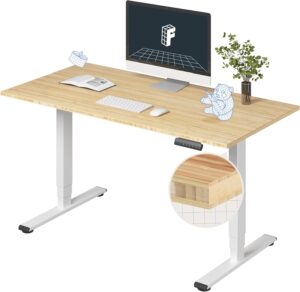
- Why it stands out: Heavy-duty dual motors, stable frame, and customizable desktop sizes.
- Best for: Professionals with multiple monitors or heavier setups.
- Buyer tip: Look for bundles that include cable management kits to keep your workspace tidy.
2. Uplift V2 Electric Standing Desk
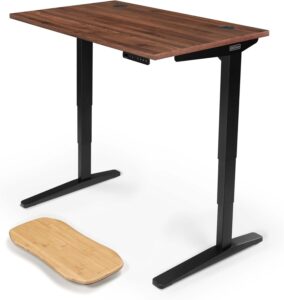
- Why it stands out: Premium build quality, whisper-quiet motors, and industry-leading 15-year warranty.
- Best for: Buyers who want a long-term investment desk with high-end finishes.
- Buyer tip: The accessory ecosystem (monitor arms, drawers, mats) makes it easy to build a complete workstation.
3. SHW 55-Inch Electric Height Adjustable Computer Desk
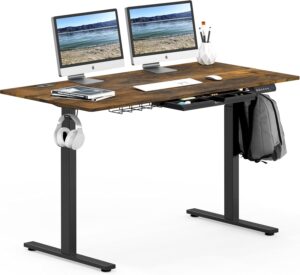
- Why it stands out: Affordable entry-level option with programmable height presets.
- Best for: First-time buyers who want to test the benefits of an electric desk without overspending.
- Buyer tip: Ideal for smaller rooms or students needing a budget-friendly option.
4. Vari Electric Standing Desk
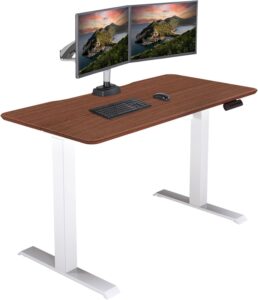
- Why it stands out: Ships almost fully assembled, strong lift capacity, and wide range of desktop finishes.
- Best for: Anyone who dreads complicated assembly and wants a quick setup.
- Buyer tip: Often goes on sale, making it a strong mid-range option.
5. ApexDesk Elite Series
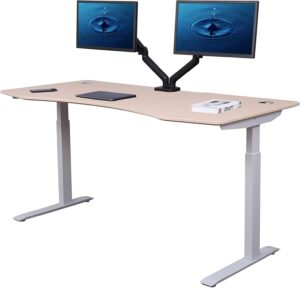
- Why it stands out: Spacious 71-inch surface option, sturdy build, and smooth dual-motor lift.
- Best for: Designers, gamers, or anyone who needs extra desktop real estate.
- Buyer tip: Great for setups that require multiple monitors or creative equipment.
Each of these electric desks offers a different balance of price, size, and features. The best choice depends on your budget and how you use your workspace — but with Amazon’s wide range, it’s easy to find one that matches your needs.
Best Manual Standing Desks
Manual standing desks may not have the bells and whistles of electric models, but they’re affordable, dependable, and often easier to maintain. If you’re looking for a straightforward desk that gets the job done, here are some of the best-rated manual options available on Amazon.
1. SHW Hand Crank Adjustable Height Desk
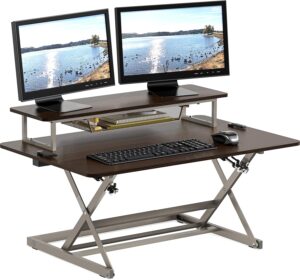
- Why it stands out: Budget-friendly entry point into standing desks, with a smooth crank system.
- Best for: Students and home office users who want adjustability without spending much.
- Buyer tip: Works well in small apartments thanks to its compact size.
2. Seville Classics Airlift Pneumatic Desk
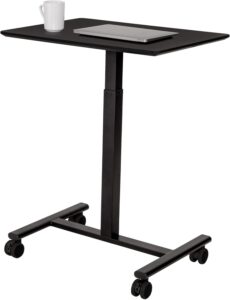
- Why it stands out: Gas-spring pneumatic lift makes adjustments faster than a crank.
- Best for: Buyers who want a lightweight desk that’s easy to move.
- Buyer tip: Great for occasional use or shared spaces like dorms.
3. Stand Steady Tranzendesk

- Why it stands out: Extra-wide surface and simple crank mechanism built for stability.
- Best for: Remote workers who need more workspace at a low cost.
- Buyer tip: Ideal for dual-monitor setups on a budget.
4. Vivo Crank Adjustable Standing Desk Frame
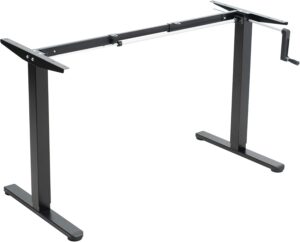
- Why it stands out: Lets you pair the frame with your own desktop for customization.
- Best for: DIYers who want to choose their own desktop material and size.
- Buyer tip: Perfect if you already have a tabletop and want to save money.
5. Safco Crank Adjustable Desk
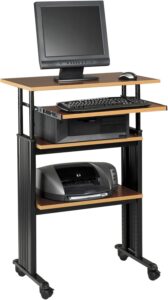
- Why it stands out: Industrial-grade build with high weight capacity.
- Best for: Users with heavier equipment like large monitors or studio gear.
- Buyer tip: A solid option if durability is your top priority.
Manual desks give you the flexibility of standing without the higher upfront cost of an electric model. For buyers who don’t adjust their desks frequently, these can be a smart, cost-effective solution.
Read Next: 8 Best Space-Saving Electric Standing Desks for Compact Rooms
Buying Guide – Key Factors to Consider
Before hitting “Add to Cart,” it’s worth thinking through what really matters in a standing desk. Whether you’re leaning toward electric or manual, these factors will help you narrow down your options and avoid buyer’s remorse.
1. Budget
- Manual desks are generally more affordable, starting around $150–$250.
- Electric desks usually start at $300 and climb into the $800–$1,000+ range for premium models.
Decide how much you’re willing to spend up front, since features scale quickly with price.
2. Height Range
Check the listed minimum and maximum height settings. If you’re taller than 6’2” or shorter than 5’2”, you’ll want a desk that accommodates your frame comfortably.
3. Weight Capacity
A lightweight desk might be fine for a laptop, but if you’re running dual monitors, speakers, or heavier equipment, make sure your desk can handle the load. Electric desks typically support more weight than manual ones.
4. Adjustment Speed & Ease
- Electric desks: Smooth and fast — usually less than 20 seconds to switch positions.
- Manual desks: Slower, and you’ll feel the effort if you adjust often.
5. Noise Level
If you work in a shared space, noise matters. Electric desks with dual motors tend to be quieter, while manual crank systems can be noticeable when adjusting.
6. Stability
Look for sturdy frames and solid construction, especially if you type vigorously or use multiple monitors. Wider bases and crossbars often mean less wobble.
7. Features & Extras
- Electric: memory presets, USB ports, anti-collision sensors.
- Manual: simple but durable with fewer parts that can fail.
Decide if these extras are nice-to-have or must-have.
8. Assembly & Setup
Electric desks are heavier and often take longer to assemble. Manual desks tend to ship in lighter boxes and require less complex setup.
A standing desk is an investment in your health and productivity. Think carefully about how often you’ll adjust it, how much equipment you’ll place on it, and what level of convenience you expect — those details will guide you toward the right choice.
Read Next: Top 7 Adjustable Electric Standing Desks for Under $300 on Amazon (2025 Guide)
FAQs – Electric vs Manual Standing Desks
1. What is the main difference between an electric and a manual standing desk?
The primary difference lies in how the desk height is adjusted. Electric standing desks use a motorized system powered by electricity, while manual desks rely on a hand crank or pneumatic lever. Electric desks are more convenient and precise, while manual desks are usually more affordable and require physical effort.
2. Which type of standing desk is better for home offices?
For home offices where comfort and convenience are key, electric standing desks are often preferred. They allow smooth transitions between sitting and standing with minimal effort. However, if you’re budget-conscious and don’t mind manual adjustment, a manual desk can still be a great choice.
3. Are electric standing desks noisy?
Most modern electric standing desks are designed to operate quietly, with noise levels averaging between 40–60 decibels (similar to a soft hum). High-quality models are nearly silent, but cheaper models may produce more noticeable motor noise.
4. Do manual standing desks take a long time to adjust?
Manual desks typically take longer to adjust compared to electric ones. For example, raising a desk manually can take 30–60 seconds, depending on the mechanism, while an electric desk can adjust in 10–20 seconds with the push of a button.
5. Which desk type is more durable in the long run?
Both can be durable if made with quality materials. Manual desks have fewer electronic parts, so they’re less likely to suffer from motor failures. Electric desks, while reliable, may require occasional maintenance or motor replacement after years of heavy use.
6. Are electric standing desks worth the higher cost?
If convenience, time-saving, and precise adjustments matter to you, then yes—they’re worth the investment. For those on a tight budget or who don’t adjust their desk height often, a manual desk may be the more practical option.
7. Can manual standing desks support as much weight as electric ones?
Weight capacity varies by model. Some manual desks can hold as much or even more than electric ones, but high-end electric desks usually have higher weight capacities (200–300 lbs or more), making them ideal for multiple monitors and heavy setups.
8. What happens if the power goes out with an electric desk?
If the power goes out, the desk will remain at its current height until electricity is restored. Some premium models come with battery backup features, but most standard electric desks do not.
9. Do electric standing desks consume a lot of electricity?
No, they are energy-efficient. They only use power when adjusting height, typically consuming less than 200 watts during operation. At idle, most consume negligible energy (less than 0.5 watts).
10. Which desk is better for shared or multi-user environments?
Electric standing desks are more suitable for shared spaces since they allow multiple users to quickly adjust the height to their preference. Manual desks, while functional, can be inconvenient in multi-user scenarios due to the extra effort required for frequent adjustments.
11. Are manual standing desks harder to use for people with physical limitations?
Yes, manual desks can be challenging for users with mobility issues, joint pain, or limited strength. Electric desks are far more user-friendly since adjustments require no physical effort.
12. Which type is easier to assemble?
Manual desks often have simpler mechanisms and fewer electronic components, making them slightly easier to assemble. Electric desks may require extra care during installation due to motors and wiring, though most modern models come with clear instructions.
Final Recommendation
Both electric and manual standing desks bring clear benefits, but the right choice depends on your priorities. If you want effortless height adjustments, quiet operation, and advanced features like memory presets, an electric standing desk is the smarter long-term investment. It’s especially ideal if multiple people will use the desk or if you switch frequently between sitting and standing throughout the day.
On the other hand, if you’re shopping on a tighter budget or only plan to adjust your desk height occasionally, a manual standing desk can still deliver the health and productivity benefits of a sit-stand setup—without the higher price tag.
Our recommendation:
- Go electric if convenience, speed, and daily use matter most.
- Choose manual if simplicity and affordability are your top concerns.
Whichever route you take, investing in a standing desk is a step toward a healthier, more productive workspace that adapts to your lifestyle.
